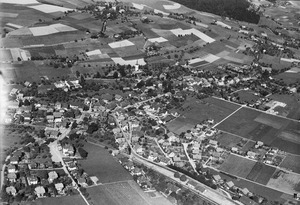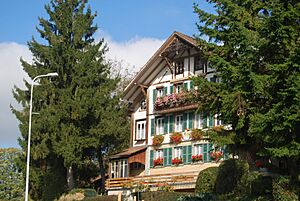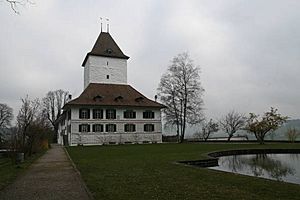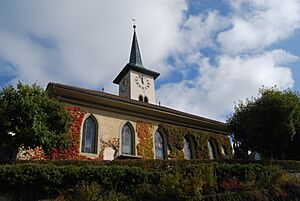Grosshöchstetten facts for kids
Quick facts for kids
Grosshöchstetten
|
||
|---|---|---|
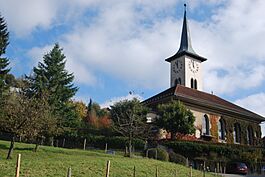 |
||
|
||
| Country | Switzerland | |
| Canton | Bern | |
| District | Bern-Mittelland | |
| Area | ||
| • Total | 3.47 km2 (1.34 sq mi) | |
| Elevation | 745 m (2,444 ft) | |
| Population
(Dec 2020 )
|
||
| • Total | 4,143 | |
| • Density | 1,193.9/km2 (3,092/sq mi) | |
| Postal code |
3506
|
|
| Surrounded by | Arni, Biglen, Konolfingen, Mirchel, Oberthal, Schlosswil, Zäziwil | |
| Twin towns | Zirovnice (Czech Republic) | |
Grosshöchstetten is a town, also called a municipality, in the Bern-Mittelland area of Bern canton in Switzerland. On January 1, 2018, the nearby town of Schlosswil joined with Grosshöchstetten.
Contents
History of Grosshöchstetten
Grosshöchstetten was first mentioned in old writings in 1146. Back then, it was called Honsteten. Until 1896, its name was simply Höchstetten.
The oldest signs of people living here are two ancient graves. These graves are from the La Tene culture, which was an Iron Age culture. They were found in the Buchelhüsli and Hürnbergacker areas.
During the Middle Ages, different noble families owned parts of the village. Eventually, much of Grosshöchstetten became part of the Herrschaft of Signau. A Herrschaft was like a territory ruled by a lord.
The village church was first mentioned in 1230. However, it was built on top of an even older building from the 11th century. In 1528, the city of Bern became Protestant. After this, Bern gained control over the church.
In the same year, the Herrschaft of Wil bought the village from Signau. By 1534, Grosshöchstetten was fully part of Wil. The church building you see today was built much later, in 1811.
Growth and Development
Grosshöchstetten was located at an important crossroads. It sat where the roads from Bern to Lucerne and from Burgdorf to Thun met. This made it a key stopping point for travelers and traders.
Because of its good location, Grosshöchstetten became a market town in 1834. This meant it had regular markets where people could buy and sell goods. A dairy and cheese factory opened in 1839.
In 1899, a railway line was built, connecting Burgdorf and Thun. This made Grosshöchstetten an even more important place for transportation.
The town also grew in other ways. A secondary school opened in 1856. A hospital, which became a district hospital, opened in 1879.
Starting in the 1870s, many skilled workers and factories moved to the town. A biscuit factory opened in 1901 and operated until 1970. In the 1960s, more industries came to Grosshöchstetten. These included factories that made metal coatings and household appliances. This growth led to more people moving to the town and many new houses being built.
Geography of Grosshöchstetten
Grosshöchstetten covers an area of about 3.4 square kilometers (1.3 square miles). A large part of this land, about 56.6%, is used for farming. Forests cover about 17.9% of the area.
About 24.9% of the land is built up with buildings and roads. This includes industrial buildings, houses, and transportation areas. There are also parks and sports fields.
The town is located between two important river valleys: the Aare valley and the Emme valley.
In 2010, Grosshöchstetten became part of a new administrative area. This new area is called Verwaltungskreis Bern-Mittelland.
Coat of Arms
The coat of arms for Grosshöchstetten shows a green beech tree on a gold background. The tree's trunk and roots are red.
People of Grosshöchstetten (Demographics)
Grosshöchstetten has a population of about 3,233 people (as of December 2011). About 8.6% of the people living here are from other countries.
Most people in Grosshöchstetten speak German. About 92.3% of the population speaks German as their main language. Italian is the second most common language, spoken by about 1.9% of people. Albanian is third, spoken by 1.7%.
In 2008, about 48.8% of the population was male and 51.2% was female. Most people living in Grosshöchstetten were born in Switzerland. About 26.7% were born right in Grosshöchstetten.
Children and teenagers (ages 0-19) make up about 21.5% of the population. Adults (ages 20-64) are about 59.4%. Seniors (over 64) make up 19.1%.
Many people in Grosshöchstetten are married. In 2000, about 1,585 people were married. There were also many single people, widows, and divorced individuals.
Most homes in Grosshöchstetten are lived in all year round. In 2000, about 94% of apartments were permanently occupied.
The chart below shows how the population of Grosshöchstetten has changed over time:

Important Historic Sites
Schlosswil Castle and its park are very important. They are listed as a Swiss heritage site of national significance. This means they are protected because of their historical and cultural value.
Economy and Jobs
In 2011, the unemployment rate in Grosshöchstetten was low, at 1.51%. This means most people who wanted jobs had them.
In 2008, there were 1,264 people working in the town. These jobs were in different areas:
- Primary sector: This includes jobs like farming. About 73 people worked in this area.
- Secondary sector: This includes jobs in manufacturing and construction. About 388 people worked here.
- Tertiary sector: This includes jobs in services, like sales, transportation, hotels, healthcare, and education. About 803 people worked in this sector.
Many people who live in Grosshöchstetten also work there. However, more people leave the town for work than come into it. About 20% of workers use public transportation to get to their jobs, and 49.1% use a private car.
Religion in Grosshöchstetten
Based on a 2000 survey, most people in Grosshöchstetten are Christian. About 70.5% belong to the Swiss Reformed Church. Another 12.6% are Roman Catholic.
There are also smaller groups of other Christian faiths, like Orthodox Christians. A small number of people are Muslim or follow other religions like Buddhism or Hinduism. About 3.29% of the population do not belong to any church.
Climate
Grosshöchstetten has a climate with a good amount of rain and snow. Between 1981 and 2010, the town had about 137.9 days of rain or snow each year. On average, it received about 1304 millimeters (51 inches) of precipitation annually.
The wettest month is usually June, with about 157 millimeters (6.2 inches) of rain or snow. It rains or snows for about 13 days in June. May has the most days with precipitation, about 14.1 days, but with slightly less total rain. February is the driest month, with about 68 millimeters (2.7 inches) of precipitation over 9.6 days.
Education in Grosshöchstetten
Education is important in Grosshöchstetten. About 42.8% of the people have finished non-mandatory upper secondary education. This is like high school. About 11% have gone on to higher education, like university.
The school system in Bern canton starts with one year of optional Kindergarten. After that, students attend six years of Primary school. Then, they go to three years of lower Secondary school. In secondary school, students are grouped based on their abilities. After lower Secondary, students can choose to continue their education or start an apprenticeship (learning a trade).
During the 2010–11 school year, 438 students attended schools in Grosshöchstetten.
- There were 2 kindergarten classes with 42 students.
- There were 12 primary classes with 201 students.
- There were 10 lower secondary classes with 195 students.
The town also has a public library called Schul- und Gemeindebibliothek Grosshöchstetten. In 2008, the library had over 10,000 books and other media. It loaned out more than 38,000 items that year.
Transportation
Grosshöchstetten has its own railway station, Grosshöchstetten. This station is on the Burgdorf–Thun line. You can take trains from here to Thun, Konolfingen, and Solothurn.
See also
 In Spanish: Grosshöchstetten para niños
In Spanish: Grosshöchstetten para niños





